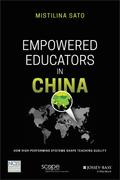Empowered Educators in China
How High-Performing Systems Shape Teaching Quality

1. Edition April 2017
156 Pages, Softcover
Wiley & Sons Ltd
BEST PRACTICES FROM CHINA'S HIGH-PERFORMING SCHOOL SYSTEM
Empowered Educators in China is one volume in a series that explores how high-performing educational systems from around the world achieve strong results. The anchor book, Empowered Educators: How High-Performing Systems Shape Teaching Quality Around the World, is written by Linda Darling-Hammond and colleagues, with contributions from the author of this volume.
Empowered Educators in China describes the nation's policy reforms that built the modern Chinese educational system and the educational practices that are considered typical in China. The book spotlights Shanghai's system which is distinctive and superior. Shanghai offers a clear illustration of an educational system that continually invests in educating a diverse student population and, by measures of international comparison tests, is achieving outstanding results. Many factors contribute to the Shanghai system's ongoing success, including the students' motivation toward strong performance, the parental support for education that is culturally ingrained throughout the country, the focus that teachers place on high expectations for students, and the individual tutoring they provide. The author argues that these factors are only a partial explanation of Shanghai's success and then closely describes educational policies that support teachers' preparation, hiring, ongoing development, and opportunities for awards and leadership. These policies are based on the assumption that teachers are key to the nation's future and must be appropriately supported in order to contribute to student performance and achievement, an assumption that is also explicitly stated within Chinese law. This volume offers specific descriptions of how these national policies are translated, adapted, and enacted in Shanghai.
Acknowledgments xi
About the Sponsoring Organizations xv
About the Authors xvii
Online Documents and Videos xix
Chapter 1 The Surprising Success of Shanghai Students 1
This Study 3
Chapter 2 Situating Shanghai in China's National Education Policy Context 5
Education Financing in China 7
Building and Reforming China's Educational System through Policy 10
Establishing the Modern Chinese School System: 1986 Compulsory Education Law 12
Seeking Educational Improvement: 1995 Education Law 15
Expanding Access to Educational Opportunities: Reform in 2001 16
Addressing National Equity Issues: Compulsory Education Law Revisited in 2006 20
Expanding Access and Shifting the Curriculum Focus: 2020 National Educational Reform Plan 21
Chapter 3 China's Educational System Today 25
Governance of the National Education System 27
The Teaching Population in China 30
Chapter 4 Education in Shanghai 33
Geography and History of the City 33
Shanghai's Schools and Students 35
Meeting the Needs of Migrant Children in Shanghai's Schools 37
Controversy about Migrant Children and the PISA Exam Results 38
Governance of the Shanghai Education System 41
Education Financing in Shanghai 42
Family Commitment to Education in Shanghai 43
Educational Reform Efforts in Shanghai 44
Reforms in Curriculum and Teaching 45
Improving the Overall Quality of Schools 47
Chapter 5 Teaching in China and Shanghai 53
Teaching within the Chinese Culture 53
Establishing Teaching as a Profession: National Teacher Laws and Regulations in the 1990s 55
Ensuring Ongoing Quality of Teachers: 2004 Continuing Education Requirements 58
Current Focus on Quality and Distribution of Teaching Expertise: Teachers in the 2020 Plan 58
Responding to the 2020 Plan: 2011 Teaching Standards in China 60
How School Structure Shapes Teachers' Work 62
The "Class" Grouping of Students 62
Organizing the Physical Space of the School 63
Teachers as Curriculum Specialists 64
The School Schedule 67
Examinations 68
Teaching Practices in China 69
Teaching and Learning in Shanghai 71
Chapter 6 Teacher Preparation in China and Shanghai 79
Teacher Preparation Minimum Expectations 79
Teacher Preparation Program Design 82
Teacher Certifi cation Exams 88
Recruiting and Hiring Teachers in Shanghai 89
Inducting Beginning Teachers in Shanghai 93
Chapter 7 Supporting Teacher Professional Learning in Shanghai 97
Teacher Professional Learning in Shanghai 97
Career Ladders and Leadership for Teachers 109
Teacher Compensation and Evaluation 114
Chapter 8 Conclusion: How Teaching Culture, Policies, and Practices Support Student Performance 119
References 125


